Work and Health Programme statistics to August 2019
Published 28 November 2019
The latest release of these statistics can be found in the Work and Health Programme statistics collection.
We are seeking user feedback on this HTML version of the statistical bulletin which replaces the PDF version. Send comments to: stats-consultation@dwp.gov.uk.
1. Introduction
The Work and Health Programme (WHP) was launched in England and Wales between November 2017 and April 2018. The data covered in this publication covers the 22 months from November 2017 to August 2019.
The WHP predominantly helps disabled people, as well as the long-term unemployed and the Early Access group (which is made up of certain priority groups) to enter into and stay in work.
People are referred by Jobcentres to work with organisations known as providers, from the public, private and voluntary sectors. The providers are paid a service delivery fee as well as outcome-related payments when a person reaches either:
- a specified level of earnings once in employment
- 6 months of being in self-employment
2. Main stories
The statistics show:
- by August 2019, cumulatively 76% of all individuals referred have started on the WHP
- 73% of all people starting the WHP are from the Disability group
- 8% are from the Early Access group
- 18% are from the Long-term Unemployed group
- 63% of all people starting the WHP are male
- the number of monthly starts increased to a peak of 5,600 in March 2019 and since has been broadly stable
Since the WHP began there have been:
- 124,730 referrals for 104,770 individuals
- 79,590 starts
- 7,150 job outcomes
Note: those starting more recently have had shorter time to achieve a job outcome, therefore it is not meaningful to divide the number of job outcomes by the number of starts or referrals.
Figure 1: The number of individuals referred by eligibility group, November 2017 to August 2019
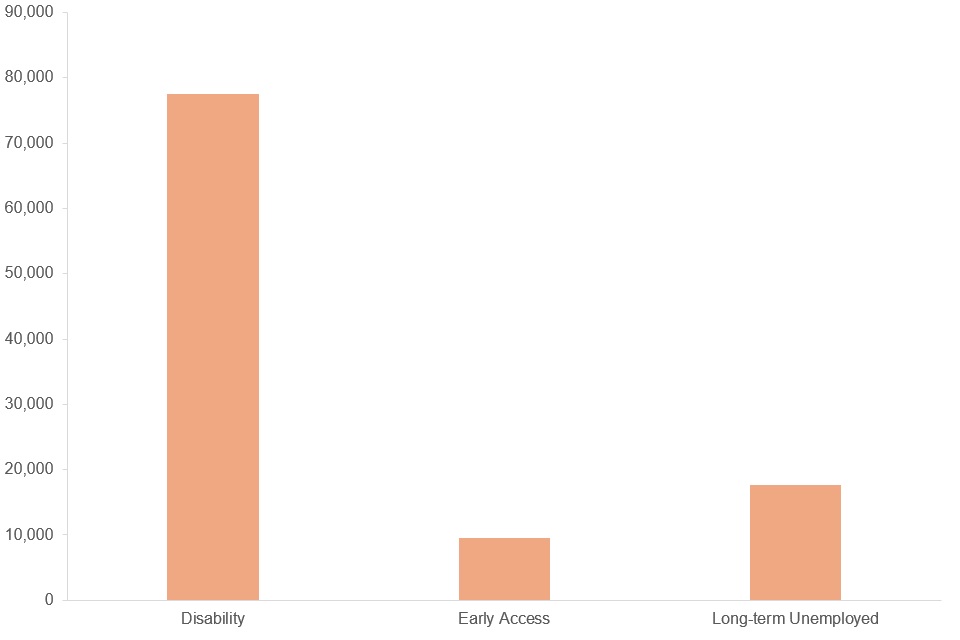
Source: WHP statistics data tables.
The majority of individuals referred are from the Disability group.
Figure 2: The percentage of programme starts achieving a job outcome within 6 months or 12 months of starting (by cohort start month), December 2017 to February 2019

Source: WHP statistics data tables.
For full data see Table 1.2 of the tables accompanying this release.
3. What you need to know
The WHP aims to provide support to help people find and keep a job. It is available to the following 3 groups:
1. Disability group – voluntary for disabled people as defined in the Equality Act (2010), this is the main group that the WHP is aimed at
2. Early Access group – voluntary and aimed at people who may need support to move into employment and are in one of a number of priority groups (for example, homeless, ex-armed forces, care leavers, refugees)
3. Long-term Unemployed group – mandatory for Jobseeker’s Allowance or Universal Credit claimants who have reached 24 months of unemployment
WHP participants may be in receipt of:
- Jobseeker’s Allowance (JSA)
- Employment and Support Allowance (ESA)
- Income Support (IS)
- Universal Credit (UC)
Additionally, it is possible to join WHP even if not receiving benefits, as people can be signposted to WHP by approved organisations.
WHP is delivered across England and Wales by 5 providers across 6 areas, known as Contract Package Areas (CPA).
In London and Greater Manchester, where devolution deals are in place, the WHP is commissioned and contract managed by the local authorities, known as Local Government Partners (LGP), who are match-funded by the European Social Fund (ESF).
In some areas, the government is designing WHP with the help of Local Enterprise Partnerships and City Regions. These are known as Devolution Deal Areas (DDA).
For more information about this see Table 2.2 of the tables accompanying this release.
Definitions
The following definitions are used in the statistics.
Referrals
Work coaches in Jobcentre Plus offices will send details of a person wanting to join WHP to a provider. When a provider acknowledges the referral and contact has been established with the participant, this is called a referral. WHP participants can be referred more than once. Figures presented in this publication do not include cancelled or rejected referrals.
Individuals referred
As referrals can include multiple referrals for one individual, individuals referred is the number of individual people referred. This means only the first referral per person is counted.
Starts
A start on the programme is recorded when a WHP participant attends the initial face-to-face meeting with the provider. The vast majority of starts should take place within 15 working days, although starts outside this window may occur if the customer does not attend the initial meeting within this time frame.
Job outcomes
A provider is classed as achieving a job outcome when a participant reaches either:
- a specified level of earnings once in employment (which varies across the different areas - see background information note for details)
- 6 months of being in self-employment.
Read the background information note for further information on WHP policy and definitions.
4. Joining the Work and Health Programme
The number of monthly starts to WHP increased to a peak of 5,600 in March 2019 and has since remained relatively stable.
Figure 3: Monthly number of referrals and starts, November 2017 to August 2019
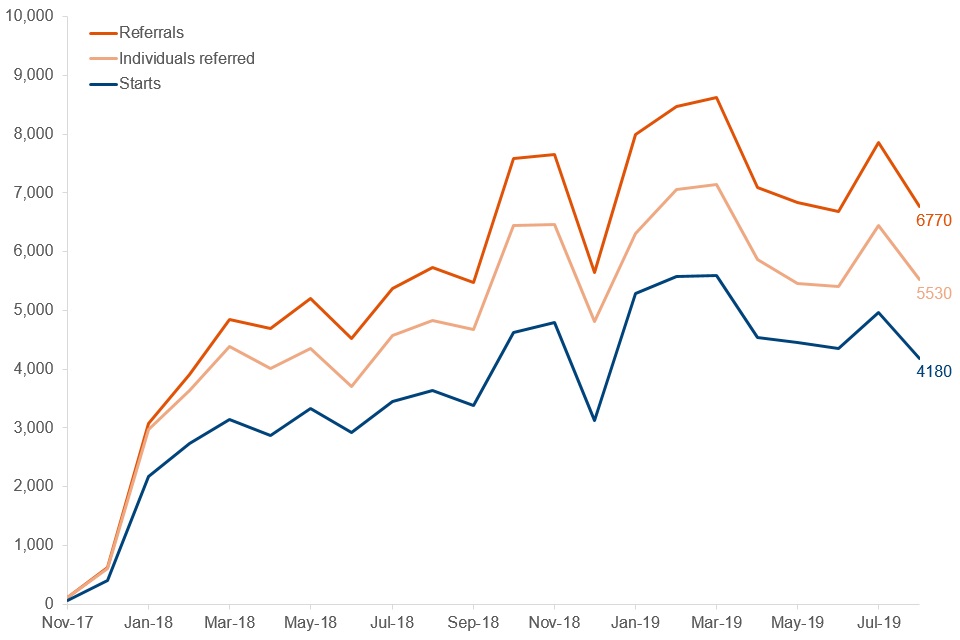
Source: WHP statistics data tables.
During the first few months of WHP, monthly referrals and starts built up as WHP rolled out across all areas of England and Wales.
The total number of monthly starts was on an upward trend between April 2018 (when the programme was available to all areas of the country and all groups of participants) and March 2019 where monthly starts reached a peak of 5,600. Since then, the number of monthly starts is broadly stable with 4,180 monthly starts in August 2019.
Since the start of the programme, nationally there have been a total of:
- 124,730 referrals
- 104,770 individuals referred
- 79,590 starts
Overall, the proportion of individuals referred that have started is 76%.
For more information see Table 1.1 of the tables accompanying this release.
The majority of starts are made by people in the Disability group.
Figure 4: Starts by eligibility group, November 2017 to August 2019
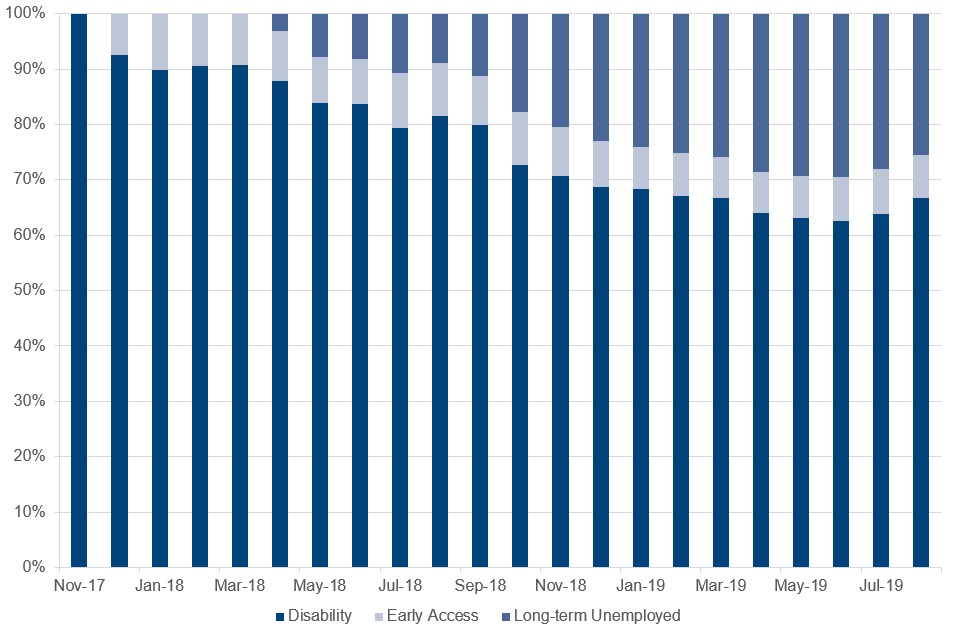
Source: WHP statistics data tables.
March 2018: WHP available to all areas of the country
April 2018: Long-term Unemployed referrals began
October 2018: More Long-term Unemployed and Disability group referrals accepted
In line with the nature of the programme, large numbers of people with disabilities or health conditions (the Disability group) are joining WHP.
People are also eligible for WHP if they are long-term unemployed, or belong to certain priority groups (known as the Early Access group).
Since the start of the programme, the majority of individuals referred (74%) and starts (73%) come from the Disability group. The proportions are comparable across all stages (referrals, individuals referred and starts). The first referrals from the Long-term Unemployed group were made in April 2018.
The Long-term Unemployed group accounts for 17% of individuals referred and 18% of starts. The Early Access group accounts for 9% of individuals referred and 8% of starts.
In the latest month (August 2019):
- 67% of starts were from the Disability group
- 8% of starts were from the Early Access group
- 26% of starts were from the Long-term Unemployed group
For full data see Table 1.1 of the tables accompanying this release.
5. Work and Health Programme referrals and starts by area
Since March 2018, all areas are contributing to WHP, delivering referrals and starts.
Figure 5: Distribution of all WHP individuals referred and starts across areas: from November 2017 to August 2019 (National)
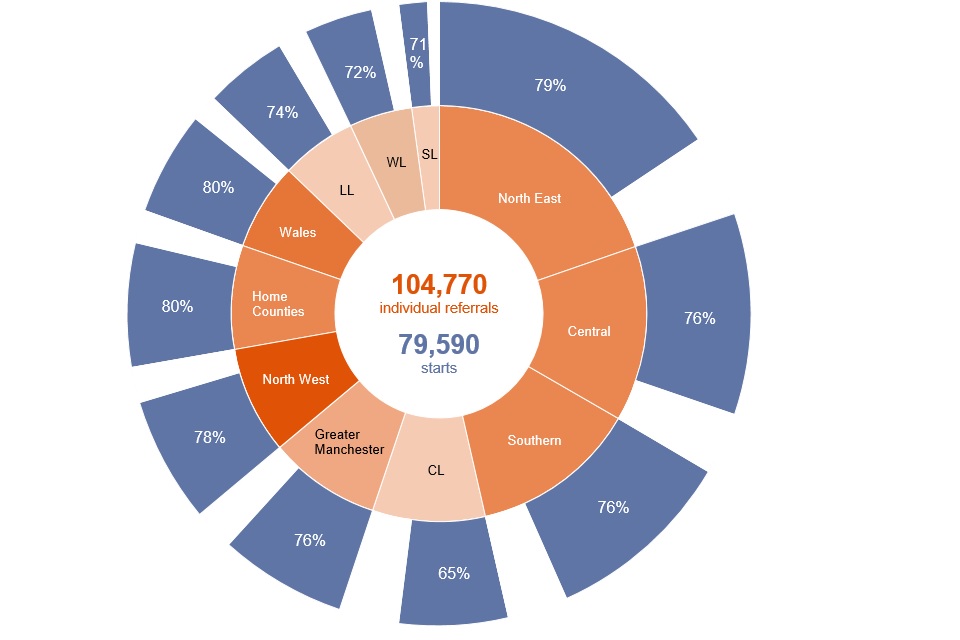
Source: WHP statistics data tables.
Each section within the inner ring shows how the total number of individuals referred (104,770) is distributed across each area. The outer ring shows the percentage of starts there have been for the individuals referred in each area (79,590 in total). The darker the inner segment, the earlier the area rolled out the programme. The following table lists the areas in order of date rollout from top to bottom.
Figure 5.1: Number of referrals and starts by area, November 2017 to August 2019 by order of rollout (earliest listed first).
| Area | Date of Rollout | Referrals | Individuals referred | Starts | % of starts to individuals |
|---|---|---|---|---|---|
| North West | 27/11/2017 | 10,570 | 8,730 | 6,840 | 78% |
| Wales | 01/12/2017 | 8,010 | 7,100 | 5,680 | 80% |
| Central | 15/01/2018 | 17,680 | 14,310 | 10,940 | 76% |
| North East | 15/01/2018 | 23,260 | 20,710 | 16,340 | 79% |
| Southern | 15/01/2018 | 16,070 | 13,610 | 10,320 | 76% |
| Home counties | 15/01/2018 | 10,110 | 8,510 | 6,770 | 80% |
| Greater Manchester Combined Authority | 29/01/2018 | 11,250 | 9,130 | 6,920 | 76% |
| West London Alliance (WL) | 26/02/2018 | 6,210 | 5,160 | 3,720 | 72% |
| Central London Forward (CL) | 01/03/2018 | 11,690 | 9,180 | 5,950 | 65% |
| South London Partnership (SL) | 01/03/2018 | 2,620 | 2,190 | 1,560 | 71% |
| Local London (LL) | 01/03/2018 | 7,250 | 6,150 | 4,550 | 74% |
Source: WHP statistics data tables.
See the WHP methodology document for maps of Greater Manchester and London LGP areas.
Clearly, there have been proportionally more referrals and starts in the North East as this is the largest area. By the same token, the smaller proportions of referrals and starts are seen in London areas, and these were also some of the final areas to roll out the programme, as well as being some of the smallest areas.
Overall, up until August 2019, the national proportion of starts to individuals referred is around 76%. Due to differences when each area began offering services and respective sizes, these figures vary across areas. However cumulatively, the highest rate of individuals referred to starts is in Wales and the Home Counties (80%) and the lowest rate of individuals referred to starts is in Central London (65%).
For full data see Table 2.1 of the tables accompanying this release.
6. Job outcomes from the Work and Health Programme
Participants are moving through the process in all areas of England and Wales.
Figure 6: The flow of participants for referrals to February 2019, for those who could achieve a job outcome by August 2019

Source: WHP statistics data tables.
Referrals after February 2019 are not presented as it is unlikely enough time has elapsed for those participants to reach the job outcomes earnings threshold (which varies across the different areas) or 6 months in self-employment. Those who were referred before February 2019 have been engaged with the programme for longer and have received more support making job outcomes more likely.
68% of all individuals referred by February 2019 have started the programme, and of these, so far 12% have reached the job outcomes earnings threshold or 6 months of being in self-employment by August 2019.
32% of individuals referred by February 2019 have not gone on to start the programme: this may, for example, be due to the participant not attending.
Participants who started the programme earliest have seen the highest level of outcomes as they have longer to reach the earning threshold or 6 months of being in self-employment.
88% of the participants who have started by February 2019 have not yet reached the job outcome earnings threshold or 6 months in self-employment by August 2019, though some of these participants have had only 6 months to achieve an outcome so far.
The national WHP and the majority of the LGPs have an earnings threshold to achieve a job outcome as 16 hours per week for 26 weeks at the National Living Wage, however the threshold for the West London Alliance is the same number of hours but at the London Living Wage and the Greater Manchester Combined Authority at the Real Living Wage.
Providers are starting to achieve job outcomes.
Figure 6.1: Job outcomes by outcome month, March 2018 to August 2019: all areas
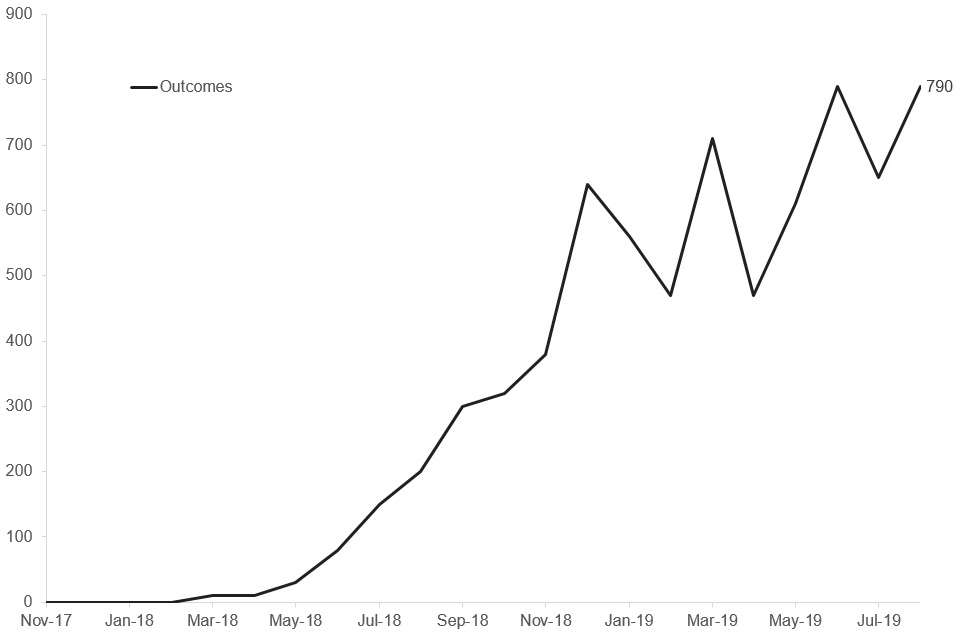
Source: WHP statistics data tables.
7,150 participants have reached the job outcome earnings threshold or reached 6 months of being in self-employment as of August 2019.
March 2018 saw the first participants reach the job outcomes earnings threshold or 6 months of being in self-employment.
For full data see Table 1.4 of the tables accompanying this release.
Job outcomes are unlikely to have been achieved for individuals who have recently started on the programme.
Figure 6.2: Total job outcomes as a percentage of starts by month started, cohorts from December 2017 to February 2019
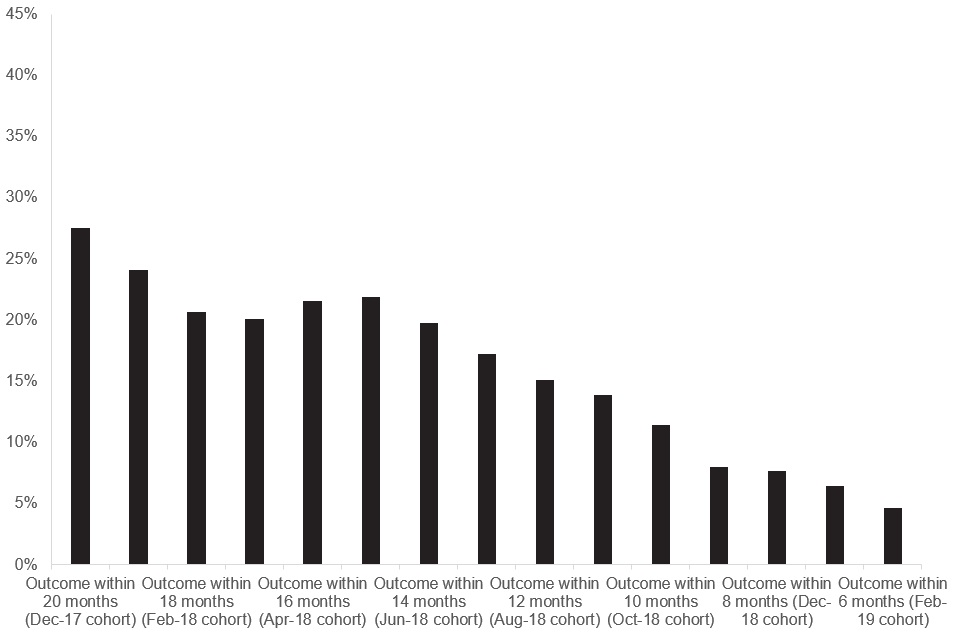
Source: WHP statistics data tables.
28% of starts from the first monthly cohort (December 2017) achieved a job outcome within 20 months of starting. Of those 25% come from the Disability group and 3% from the Early Access group.
More recent start months are therefore likely to report lower levels of outcomes as participants haven’t had as much time on the programme.
The percentage of job outcomes by starts for the Disability group mirrors the trend of the percentage of the total job outcomes by starts.
Percentages are more changeable in the Early Access and Long-term Unemployed groups due to lower volumes of starts and job outcomes.
The Long-term Unemployed group began accepting referrals in April 2018, therefore there are no outcomes before this point.
For full data see Table 1.3 of the tables accompanying this release.
Figure 6.3: Disability group job outcomes as a percentage of starts by month started, cohorts from December 2017 to February 2019
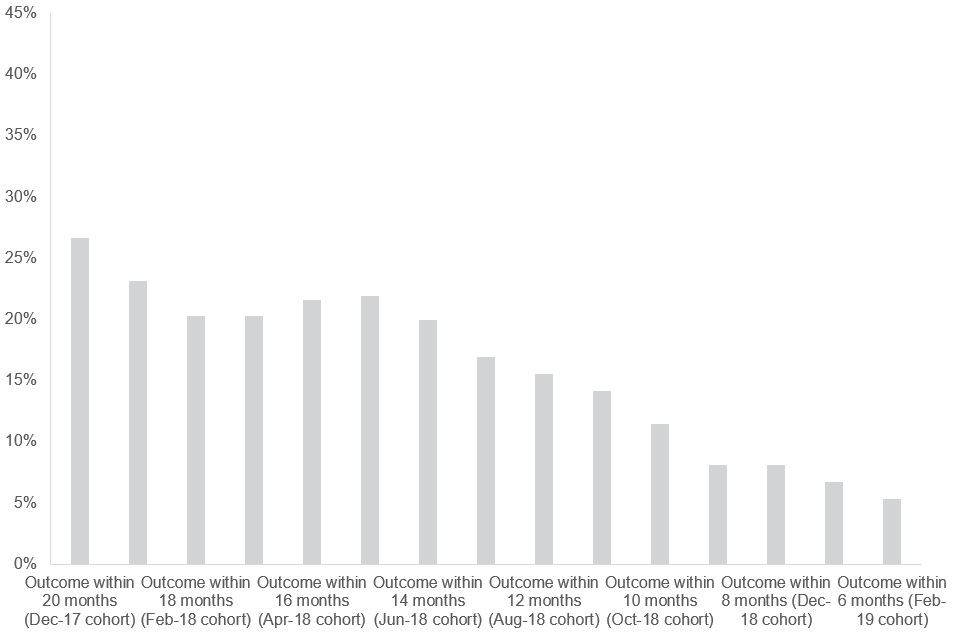
Source: WHP statistics data tables.
Figure 6.4: Early Access group job outcomes as a percentage of starts by month started, cohorts from December 2017 to February 2019

Source: WHP statistics data tables.
Figure 6.5: Long-term Unemployed group job outcomes as a percentage of starts by month started, cohorts from December 2017 to February 2019

Source: WHP statistics data tables.
Standardised monthly performance measure at 6 and 12 months
Figure 6.6: Percentage of starts achieving a job outcome within 6 months of starting by start month and eligibility group, December 2017 to February 2019
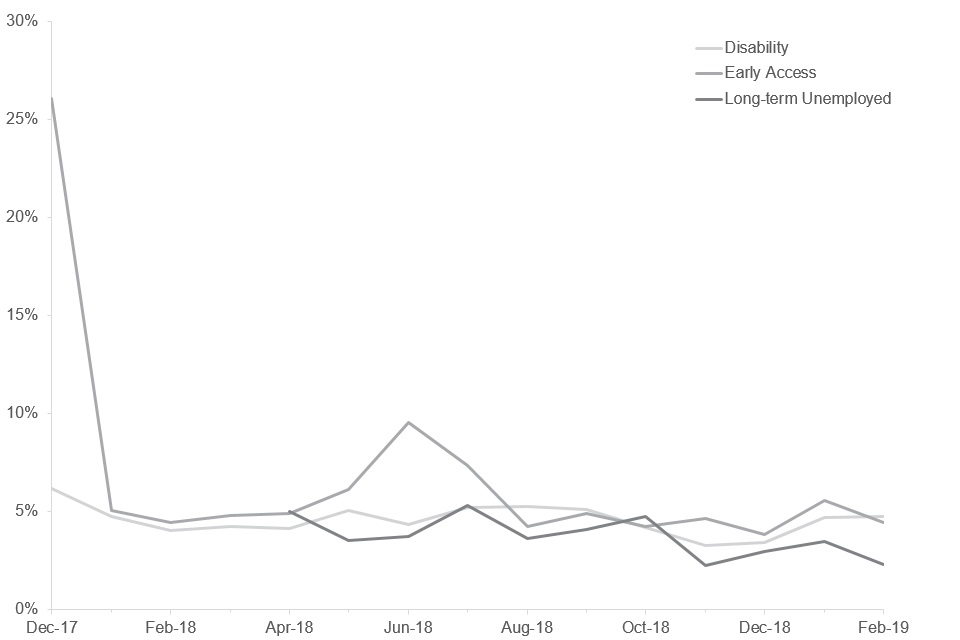
Source: WHP statistics data tables.
Over time, the proportion of job outcomes achieved within 6 months of starting the programme has ranged between:
- 3% and 6% for those from the Disability group
- 2% and 5% for those from the Long-term Unemployed group
The Early Access group shows more change in percentages over time due to lower volumes of starts and job outcomes. This is more apparent for December 2017 and June 2018 cohorts.
The Long-term Unemployed group began accepting referrals in April 2018, therefore there are no outcomes before this point.
For full data see Table 1.2 of the tables accompanying this release.
Figure 6.7: Percentage of starts achieving a job outcome within 12 months of starting by start month and eligibility group, December 2017 to August 2018
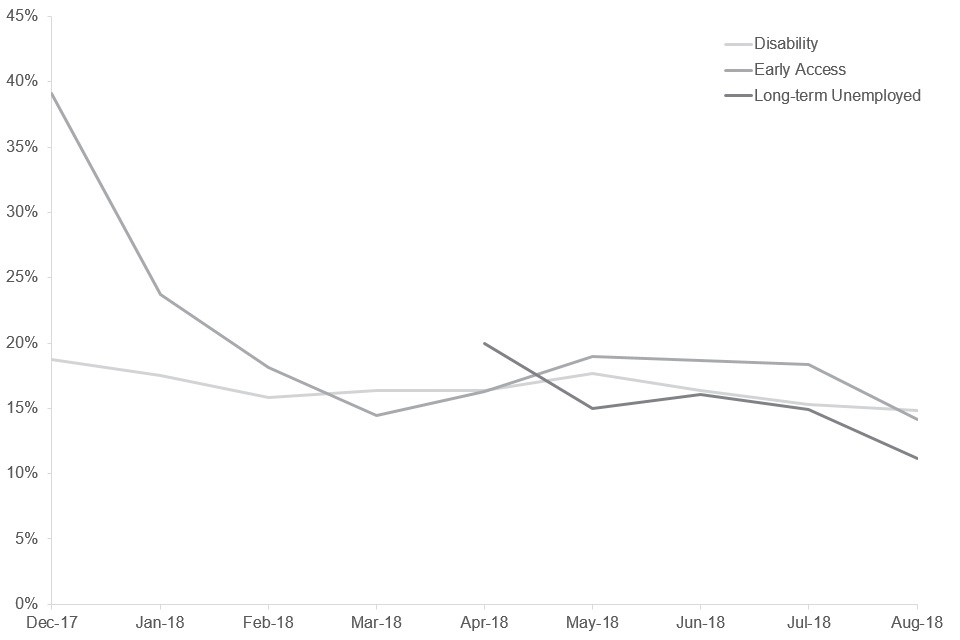
Source: WHP statistics data tables.
The proportion of job outcomes achieved by the Disability group within 12 months of starting ranges between 15% and 19%, in line with the total number of job outcomes achieved within 12 months of starting.
The Early Access group shows more change in percentages over time due to lower volumes of starts and job outcomes.
As the Long-term Unemployed group only began accepting referrals in April 2018, there are no outcomes before this point, therefore more time is needed to draw meaningful conclusions for this group.
For full data see Table 1.2 of the tables accompanying this release.
7. Demographics of the Work and Health Programme
The distribution of age varies by area.
Figure 7: Percentage of WHP starts by age group and area, November 2017 to August 2019

Source: WHP statistics data tables.
Wales has the highest proportion of 18 to 24 year olds starting the programme (16%), while West London has the highest proportion of 25 to 59 year olds starting the programme (83%).
10% of all starts to WHP were from the 60+ age group. The majority (77%) of all starts come from the 25 to 59 age group. This is to be expected as WHP is aimed at working age participants.
For further age breakdowns see Table 3.2 of the tables accompanying this release.
Almost two thirds of all WHP participants are male.
Figure 7.1: WHP starts by gender, November 2017 to August 2019
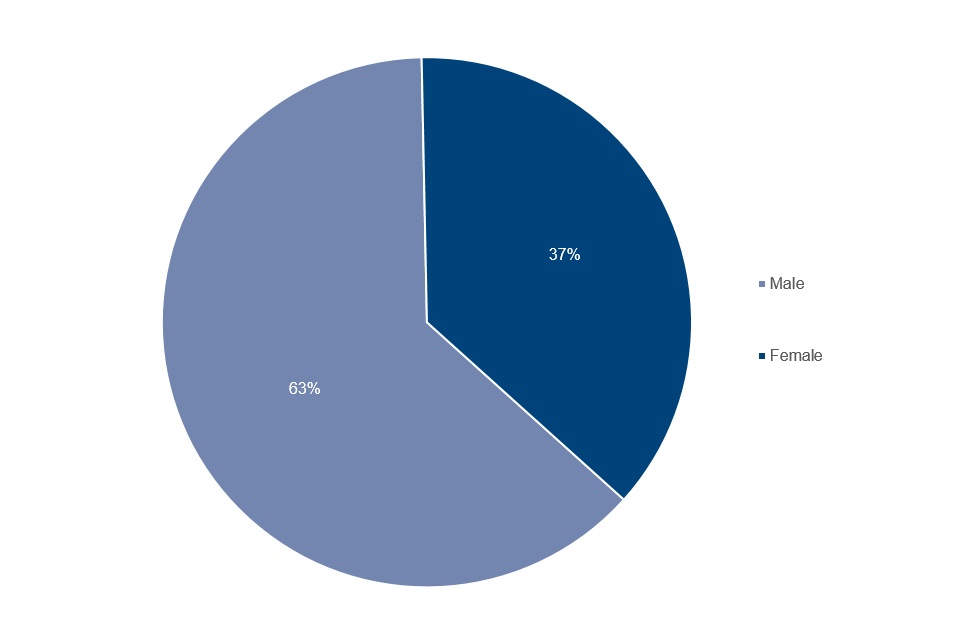
Source: WHP statistics data tables.
63% of all participants starting WHP are male.
Males consistently accounted for over 60% of all monthly participants since the start of the programme.
This proportion differs slightly across groups. For example, in the Early Access group, 68% of participants are male, in the Long-term Unemployed group 63% are male, and in the Disability group 62% of participants are male.
For full data see Table 3.3 of the tables accompanying this release.
8. About these statistics
This statistical summary gives an overview. Key points and trends are presented using charts and commentary. The information underlying the charts is available as supporting tables.
In line with our publications strategy, we aim to release additional breakdowns in future publications.
Details will be announced, in advance via StatsUserNet and the DWP statistics calendar.
Experimental statistics
Experimental statistics are Official Statistics which are published in order to involve users and stakeholders in their development and as a means to build in quality at an early stage. All Official Statistics should comply with the UK Statistics Authority’s Code of Practice for Statistics which promotes the production and dissemination of official statistics that inform decision making.
Where to find out more
Read the WHP background information note for more information about the statistics.
The Work and Health Programme provider guidance is used by programme providers.
Information on the Work Programme, a programme which aimed to get unemployed people into sustained employment can be found in the collection of Work Programme statistics.
Information on Work Choice, a programme which aimed to help disabled people find, keep and progress in a job, can be found in the collection of Work Choice statistics.
Information on Specialist Employability Support, a voluntary programme which is aimed at helping disabled people with complex barriers that other support is not suitable for to find a job, can be found in the collection of Specialist Employability Support statistics.
Information on the Access to Work provision, which is aimed at supporting people who have a disability or long-term health condition to start or stay in work, can be found in the collection of Access to Work statistics.
Contact information and feedback
For more information on WHP statistics, contact Tracy Hills.
DWP would like to hear your views on our statistical publications. If you use any of our statistics publications, we would be interested in hearing what you use them for and how well they meet your requirements. Please send your comments by email to: stats-consultation@dwp.gov.uk.
Users can also join the ‘Welfare and Benefit Statistics’ community at StatsUserNet. DWP announces items of interest to users via this forum, as well as replying to users’ questions.
ISBN: 978-1-78659-179-1
